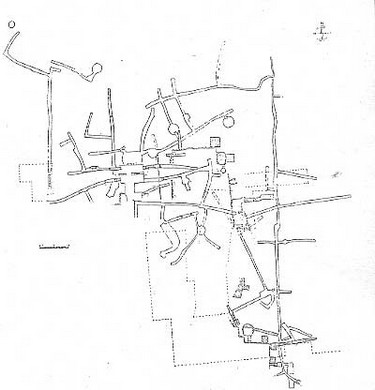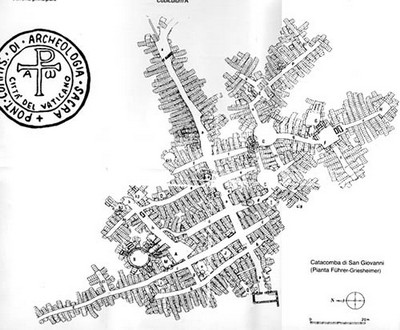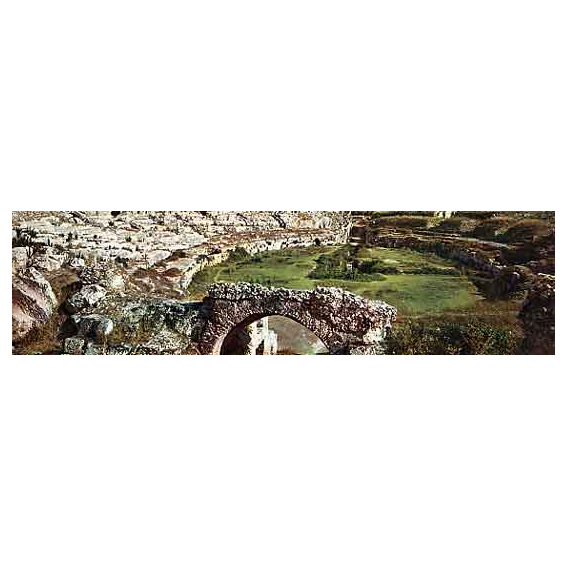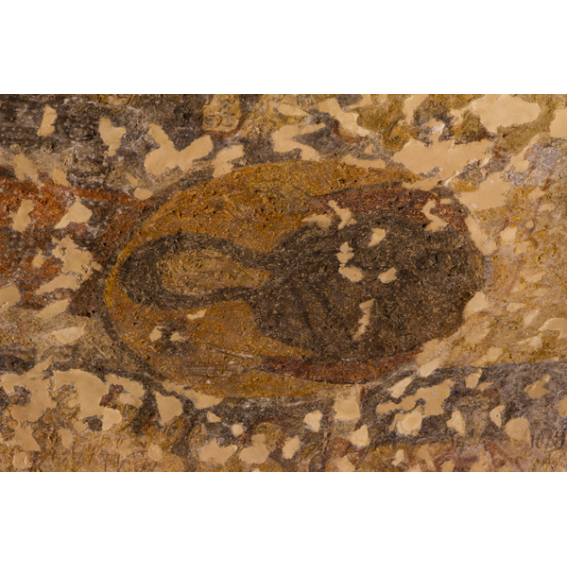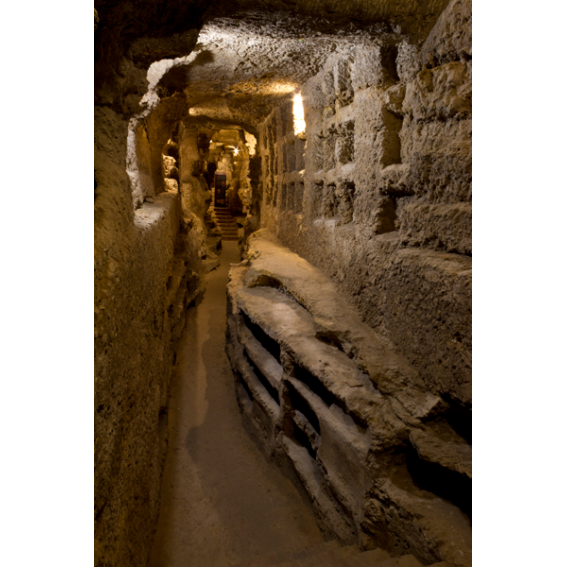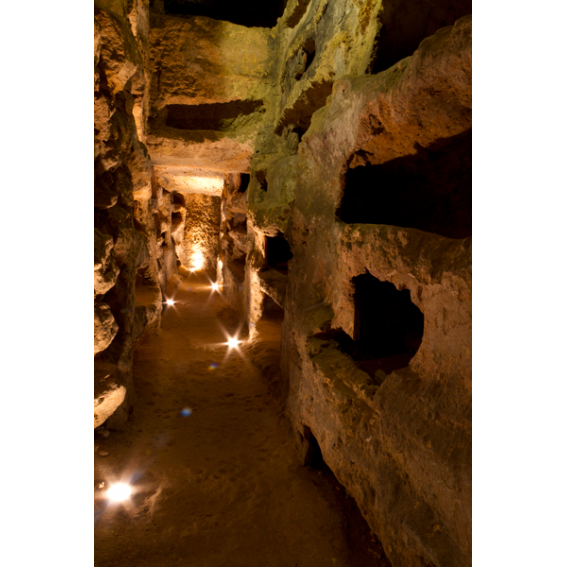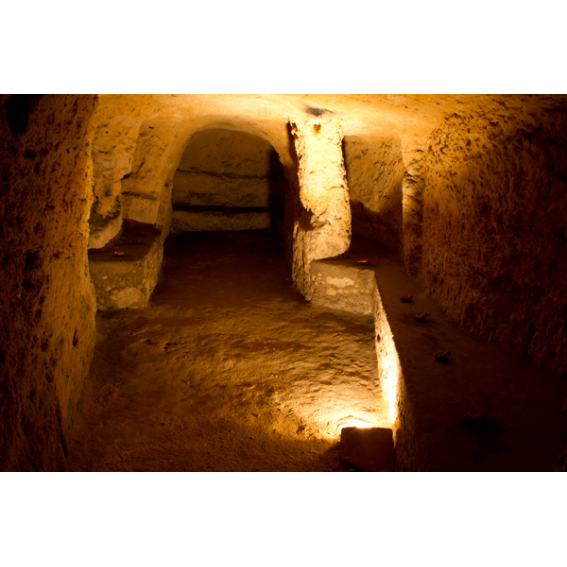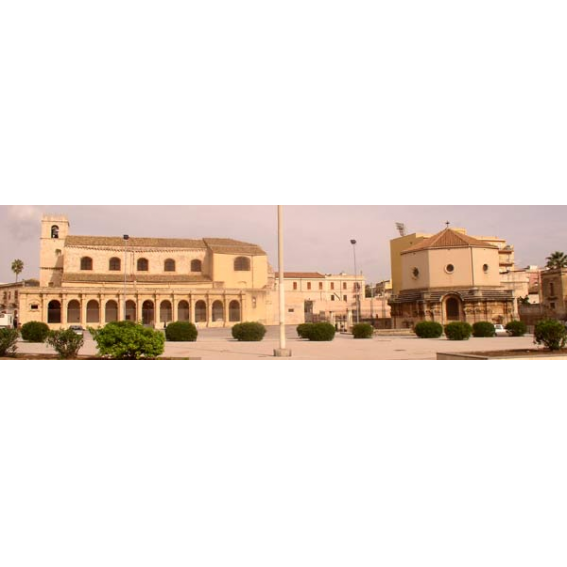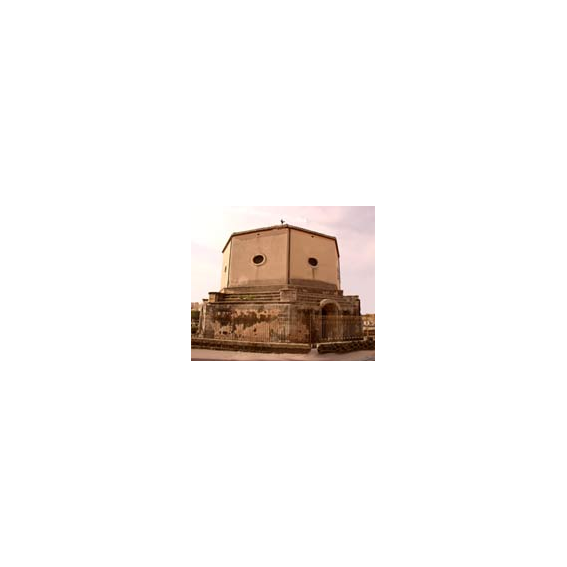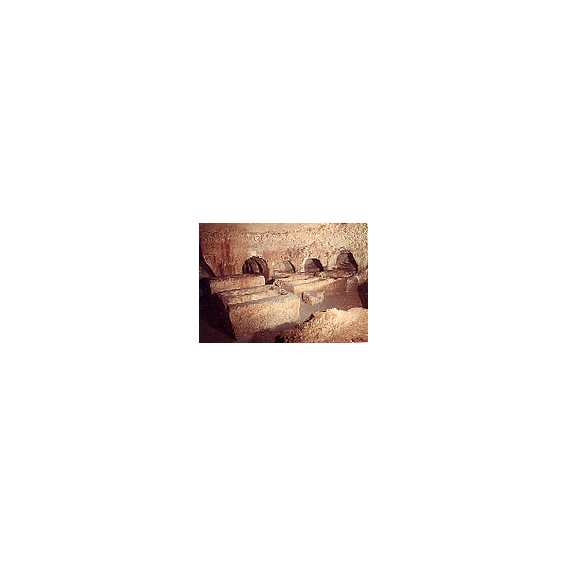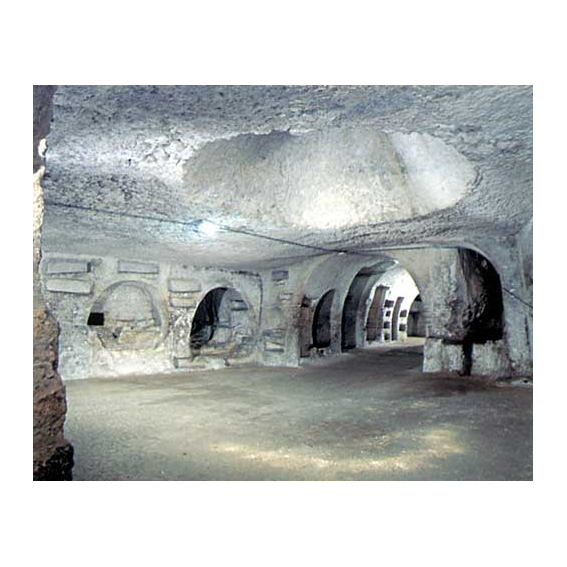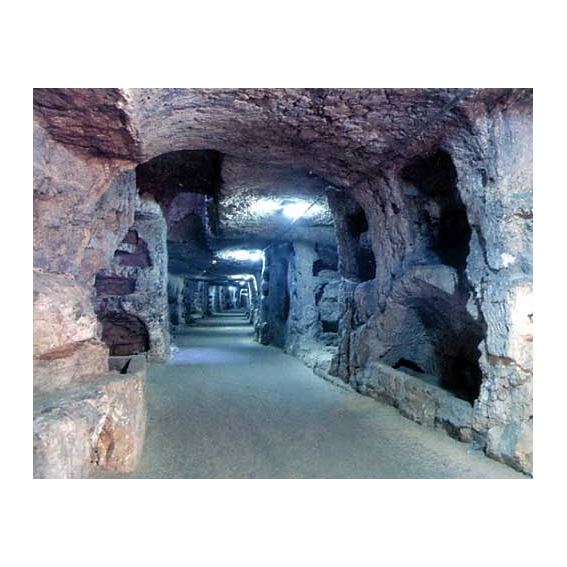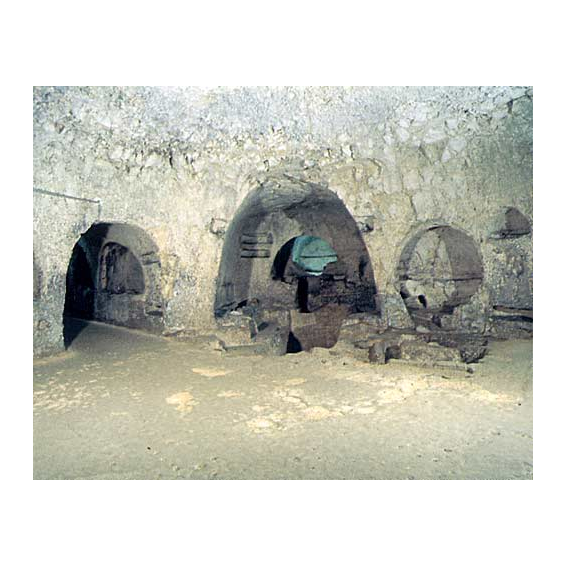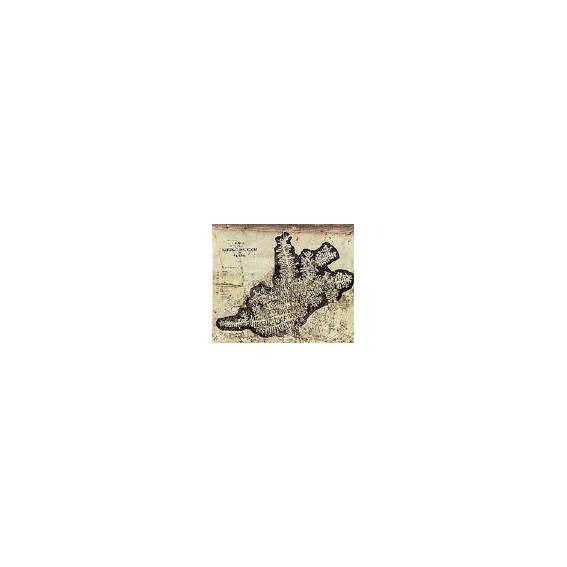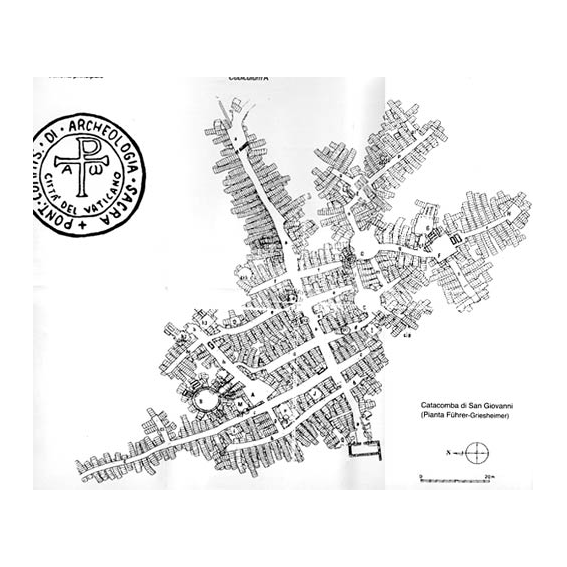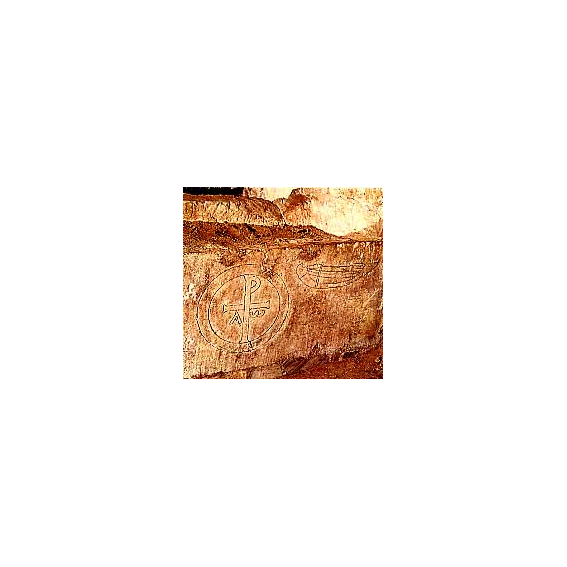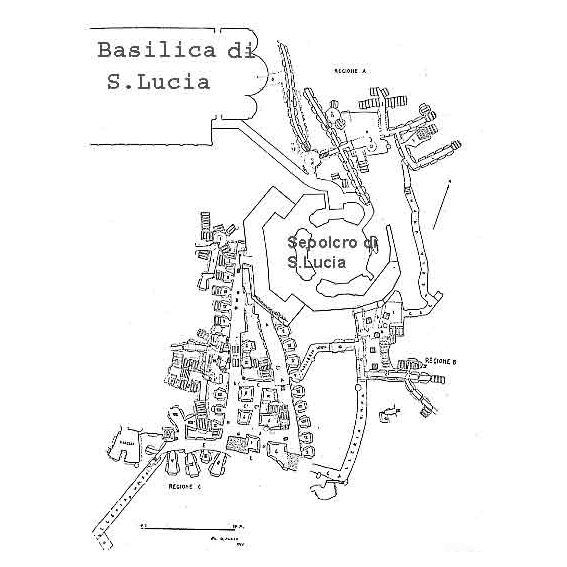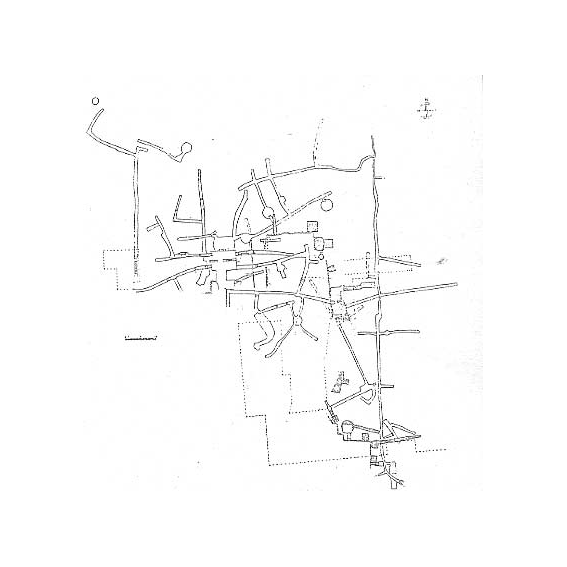catacombe
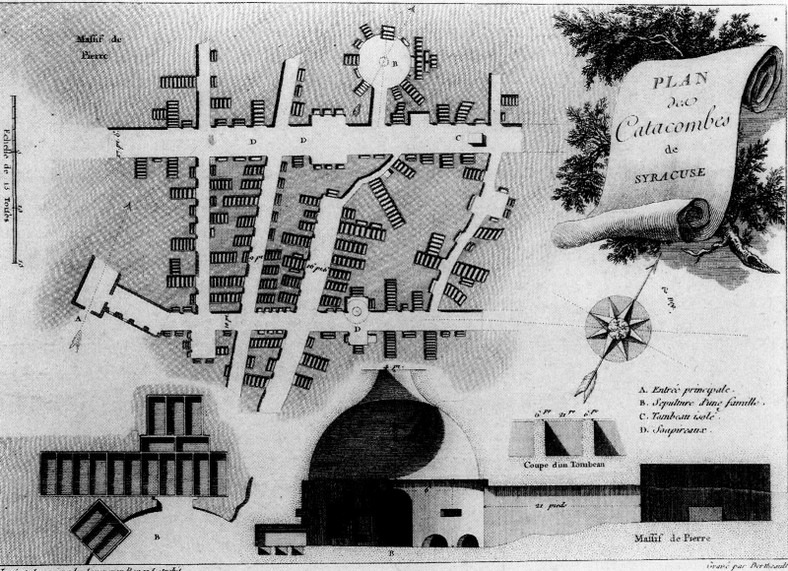

LE CATACOMBE
Siracusa possiede forse il più importante complesso di ipogei tardoantichi dopo Roma. Tra questi particolarmente importante il, gruppo delle catacombe, che si dispongono secondo un arco interno a quello formato dalle Latomie, da nord - ovest a sud-est. La localizzazione di queste aree cimiteriali è particolarmente interessante per quanto riguarda la storia urbanistica della città nel periodo tardoimperiale: esse, infatti, si inseriscono all'interno della Neapolis, lungo i margini di Acradina. Si tratta di un chiaro indizio del restringimento dell'area abitata, che si può far risalire ai secoli precedenti: le catacombe infatti, la cui utilizzazione ha inizio già nel corso del III sec. d.C., furono precedute da necropoli risalenti alla prima e alla media età imperiale. Ciò conferma con grande evidenza la notizia di Strabone (VI 2, 4), secondo cui la città, semidistrutta e quasi abbandonata nel corso della guerra tra Ottaviano e Sesto Pompeo, fu in gran parte ricostruita al momento della deduzione della colonia augustea, ma limitatamente alla sola Acradina. Del resto, probabile che le catacombe, specialmente le più antiche, non appartenessero solo alle comunità cristiane ma costituissero i cimiteri destinati a gran parte della popolazione povera.
Per quanto riguarda l'introduzione del cristianesimo a Siracusa, possediamo solo scarse notizie. S. Paolo vi passò tre giorni nel corso del suo viaggio in direzione di Roma, ciò che potrebbe far pensare all'esistenza già da allora di una piccola comunità. Il primo documento sicuro è però costituito da una lettera di S. Cipriano (30, 5) a proposito dei lapsi (cioè di coloro che abbandonavano la chiesa al momento delle persecuzioni), datata al 250-1. L'importanza della diocesi siracusana è dimostrata dal fatto che al concilio di Arles del 314 fu invitato, tra i vescovi siciliani, solo quello di Siracusa.
Traduzione di Annalisa Giammanco
The Catacombs
Siracusa probably has the most important complex of late-ancient hypogea after Roma. Between these, particular importance has the group of catacombs, sorted according to an arch inside that one of the Latomie, from the north-west to south-east. The localisation of these cemeteries areas is really interesting as to concern the urban history of the city in the late-imperial period: in fact they are inside the Neapolis, along the borders of Acradina. It’s a clear indication of the constriction of the inhabited area, coming as a consequence of the previous centuries: in fact the catacombs, of which the use started during the III millennium a. C., were preceded by necropolis from the first and middle imperial age. It confirms with evidence the news by Strabone (VI 2, 4), according whom the city, half-destroyed and almost abandoned during the war among Ottaviano and Sesto Pompeo, was for the most part rebuilt when it became Augusta colony, but only for Acradina. After all, it’s probable that the catacombs, especially the most ancient, didn’t belong only to the Christian communities, but were the cemeteries destined to the most of poor people.
As to concern the introduction of Christianity in Siracusa, we have scarce informations. S. Paolol spent there three days during his travel to Rome, and this could induce to think about the existence of a small community at that time. The first sure document is a letter by S. Cipriano (30, 5), on the lapsi (that is people who abandoned the church when there were persecutions), dated 250-1. The importance of the Siracusan diocese is demonstrated by the fact that among the Sicilian bishops, only that one from Siracusa was invited to the council of Arles in 314.
Basilica e Sepolcro di S. Lucia 
Catacomba di Santa Lucia
Sepolcro di S. Lucia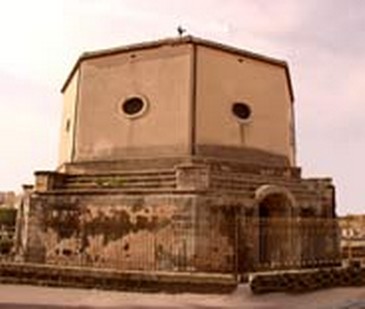
Catacombe di S. Lucia. Planimetria (da S. L. Agnello).
clicca sull'immagine per ingrandire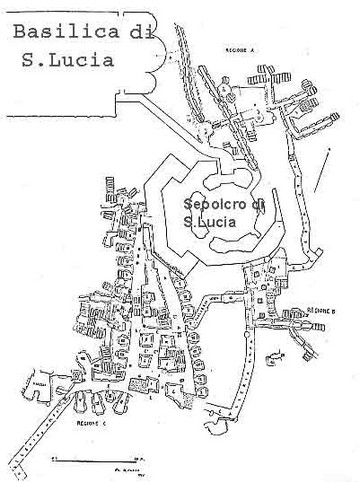
Tarde fonti agiografìche ricordano il martirio della santa siracusana, che sarebbe avvenuto il 13 dicembre del 304, durante la persecuzione di Diocleziano. Un'iscrizione scoperta nella catacomba di S. Giovanni, databile tra la fine del IV e l'inizio del V secolo, nomina la martire, e dimostra la storicità dell'episodio. La catacomba sorse intorno alla tomba della santa (il cui corpo, trasportato a Costantinopoli, fu poi trafugato dai Veneziani nel 1204, e collocato nella chiesa di S. Geremia). La costruzione nel XVII secolo della cappella ottagonale del Vermexio ha irreparabilmente sconvolto tutta l'area. Ulteriori danni sono stati provocati dalla realizzazione di rifugi antiaerei su tutta l'estensione del cimitero. Scavi recenti, iniziati nel 1952, ne hanno rivelato l'importanza e l'estensione, che ne fanno il complesso catacombale più importante e più vasto della Sicilia.
Le gallerie si dipartono in tutte le direzioni a partire dalla tomba della santa. Sono state finora identificate quattro regioni, tre delle quali sufficientemente scavate. La più antica è probabilmente
la regione A, la più settentrionale, che sembra iniziata nei primi decenni del III secolo. Come tutte le catacombe più antiche, essa comprende strette gallerie, con numerose file di loculi sovrapposti. Non vi si trovano arcosoli, e sono anche scarse le pitture e le iscrizioni.
La regione B, a sud della prima, sembra immediatamente successiva, e ancora di epoca precostantiniana. Essa riutilizza un ramo di acquedotto di età classica. Si tratta anche in questo caso di un cimitero piuttosto povero, con una sola tomba di una certa ricchezza, appartenente, come mostra un'iscrizione, a una certa Castina, romana. Le pitture che la decoravano sono ora scomparse.
La regione C, a ovest della precedente, è la più ampia e complessa. Essa è certamente postcostantiniana, ed è stata probabilmente iniziata intorno al 350, riutilizzando un acquedotto e cisterne di età classica, e anche un sacello di età repubblicana. Comprende due gallerie orientate da nord a sud (A e B), comunicanti con altri bracci di galleria (C e D). Si vengono così a formare dei grandi pilastri risparmiati, nei quali furono ricavati dei loculi. Lungo i corridoi si aprono numerosi ambienti con loculi nelle pareti e fosse nei pavimenti. Il più notevole è il cosiddetto « Cubicolo del Buon Pastore », così denominato da una decorazione dipinta con tale soggetto.
Al margine meridionale di questa regione è stato scoperto un sacello del II sec. a. C., appartenente all'officina di un vasaio (come dimostra il materiale ceramico che riempiva alcuni ambienti adiacenti). L'officina sembra in attività tra il II e il I sec. a. C. Il sacello, evidentemente luogo di culto della corporazione, reca interessantissime pitture con divinità e scene di lavoro, del tutto simili a quelle scoperte a Delo.
La regione D è solo parzialmente esplorata. Essa sembra esser sorta intorno a un più antico ipogeo pagano a incinerazione.
Nelle regioni A e C sono anche due piccoli oratori bizantini. Il primo, ricavato entro una cisterna più antica (H), conserva interessanti decorazioni dipinte (nella volta, i 40 martiri di Sebaste).
Traduzione di Annalisa Giammanco
Late hagiographic sources remember the martyrdom of the Siracusan Saint Lucia, which happened the 13 December 304, during the persecution of Diocleziano. An inscription found in the catacombs of S. Giovanni, dated between the end of the IV and the beginning of the V century, mentions the martyr, and demonstrates the historicity of the episode. The catacomb rose around the tomb of the Saint (whom body, transported to Constantinople, was then purloined by Venetians in 1204, and placed in S. Geremia church). The construction in XVII century of the octagonal chapel of Vermexio has irreparably distressed all the area. Further damages were provoked by the realisation of antiaircraft refuges along all the extension of the cemetery. Recent excavations, started in 1952, have revealed the importance and the real extension, which makes of it the most important and the widest catacomb complex in Sicilia.
The galleries branch off in all the directions from the grave of the Saint. Up to now there have been identified four regions, three of which are sufficiently excavated. The most ancient is probably the region A, the most northern, maybe started in the first decade of the III century. As all the most ancient catacombs, it includes narrow galleries, with several lines of superposed loculi. There are not found arcosolia, and there are few paintings and inscriptions.
The region B, on the south of A, seems immediately next to it, and still from the pre-Constantine age. It re-uses one of the branches of the aqueduct of the Classic age. Also in these case it’s about a poor cemetery, with only a tomb quite rich, belonging, as shows an inscription, to a certain Castina, Roman. The painting that decorated it are now disappeared.
The region C, on the west of B, is the widest and the most complex. It’s certainly post-Constantine, and was probably started about in 350, re-using and aqueduct and cisterns of the Classic age, and also a sacellum from the Republican age. It includes two galleries northwards and southwards (A and B), communicating with the other branches of the gallery (C and D). they form two big pillars not used where there were excavated loculi. Along the corridor open up many rooms with loculi in the walls and holes in the floors. The most considerable is the so-called “Cubicle of the good shepherd”, from a decoration painted with this subject. In the southern border of this region it has been found a sacellum of the II century b. C., belonging to the workshop of a ceramist (as demonstrated the ceramic material which felled up all the adjacent rooms). The workshop seemed working between the II and the I century b. C. The sacellum, cult place for the corporation, has really interesting paintings with divinities and scenes of work, similar to those ones found in Delo.
The D region has still partially explored. It seems to be raised close to a more ancient pagan IPOGEO A INCINERAZIONE. In the regions A and C there are also twp little Byzantine oratories. The first derived inside a more ancient cistern (II), conserves interesting painted decorations (in the vault, the 40 martyrs of Sebaste).
Catacomba di S. Maria di Gesù
Si trova a nord-ovest delle catacombe di S. Lucia, e comunica a est con le catacombe di Vigna Cassia. Il cimitero fu ricavato anche in questo caso da un più antico acquedotto, che ne costituisce la galleria principale, orientata nord-sud. Questa parte è anche la più antica, contemporanea di S. Lucia (primi decenni del III secolo): anche in questo caso, si tratta di una galleria con semplici ordini di loculi nelle pareti. Più tardi, dopo la pace costantiniana, fu realizzata una seconda galleria, che attraversa la precedente. In questa si aprono i tipici arcosoli polisomi (con più corpi sepolti), caratteristici della Sicilia, nei quali sono comprese fino a 30 tombe.
Catacomb of Saint Maria of Jesus
It’s in the north-west of the catacombs in Saint Lucia, and communicates in the west with the catacombs of Vigna Cassia. The cemetery was derived, also in this case, from a more ancient aqueduct, which constitutes the main gallery, oriented north-southward. This part is the most ancient, contemporaneous to that of Saint Lucia (first decades of the III century), and in this case too, it’s about a gallery with simple orders of loculi in the walls. Later, after the Constantine peace, a second gallery was realised, which crosses the previous one. In this gallery open up the typical ARCOSOLI POLISOMI ()with many bodies buried, typical in Sicilia, in which are included up to 30 tombs.
Catacomba di Vigna Cassia
Catacombe di Vigna Cassia. Planimetria (da S. L. Agnello)
E Vigna Cassia vi si entra attraverso un Antiquario, nel quale sono esposti i materiali scoperti negli scavi recenti. La regione A, la più occidentale, consiste di una lunga galleria, che sfrutta anch'essa preesistenze classiche (in tutta l'area della catacomba sono stati riconosciuti resti di botteghe di ceramisti, che dovevano evidentemente occupare tutta questa parte orientale della città). Lungo la galleria, che è di età postcostantiniana, si aprono numerosi arcosoli polisomi. In fondo, sulla destra, è l'arcosolio di Marcia, il cui nome è iscritto sulla lunetta. Vi si ammira un'interessante decorazione dipinta: nella lunetta, entro un giardino fiorito (che rappresenta il Paradiso) troneggia la figura del Cristo tra S. Pietro e S. Paolo, mentre a sinistra Marcia è rappresentata inginocchiata,con le braccia tese in posa da supplice. Si tratta evidentemente della rappresentazione del giudizio della donna nell'aldilà. In basso sono rappresentati due pavoni affrontati a un cantaro.
Attraversando la regione B si perviene al cosiddetto Cimitero maggiore, che si articola intorno a un grande ambiente rettangolare, in origine a cielo aperto. Si riteneva in genere che questa fosse stata la parte originaria del cimitero, ma recentemente si è proposto, invece, di riconoscervi una fase tarda, aggiunta in un secondo tempo al sepolcro di un martire sconosciuto. Più antiche del vestibolo sarebbero le gallerie circostanti, come si deduce dal loro tipico aspetto austero, con file di loculi sovrapposti. Ciò è confermato dai piccoli gruzzoli di monete di bronzo scoperti in alcune tombe, che non oltrepassano la data del 284. Nella regione F è il noto « Cubicolo delle Rose », con una ricca decorazione floreale dipinta.
Nella zona a nord-est dovevano essere i sepolcri di famiglie di un certo livello sociale: si tratta infatti del settore più monumentale e più ricco di pitture. Vi si notano tre rotonde, ricavate da più antiche cisterne a campana, due delle quali, sulla base di iscrizioni, sono state denominate di Victoria e di Heraclia. Tra le pitture si notano rappresentazioni di Daniele tra i leoni, di Giona, di oranti, del Buon Pastore.
E Nella zona compresa tra la catacomba di Vigna Cassia e quella di S. Maria di Gesù, a un livello più alto (ingresso dall'Antiquario), è una piccola Latomia, utilizzata in età classica da officine di vasai, e poi occupata da ipogei tardoantichi, che presentano importanti resti di pitture della fine del IV secolo: Giona, Daniele nella fossa dei leoni, l'ingresso di Gesù a Gerusalemme, la resurrezione di Lazzaro, il Buon Pastore.
And you go to Vigna Cassia through an Antiquarium, where are shown the materials found in the recent excavations. The region A, the most western, consists in a long gallery, using pre-existing classic structures (in all the area of the catacomb have been recognised rests of ceramist workshops, occupying all this oriental part of the city). Along the gallery, of the pre-Constantine age, open up several arcosolia with different shape. Deeper, on the right, it’s the arcosolia of Marcia, whom name is inscribed in the lunette. An interesting painted decoration is admired: in the lunette, inside a blossoming garden (representing the Paradise) dominates the figure of Christ between S. Pietro and S. Paolo, while on the left Marcia is represented on her knees, with tense arms, with the pose as a beggar. Surely it’s about the representation of the judgement of the woman in the hereafter. In the lower part are represented two peacocks and a singer.
Through the region B we arrive to the so-called, Main cemetery, articulated around a big rectangular room, in origin roofless. It has been thought that this was the original part of the cemetery, but recently it has been proposed to recognise in it a late phase, added secondly to the sepulchre of an unknown martyr. The surrounding galleries should be more ancient, as it can be deduced by their typical aspect of austerity, with lines of loculi superposed. It is confirmed by small hoards of bronze money found in some tombs, up to the 284.
In the region F is the famous “Cubicle of the Roses”, with a rich ancient painted flower decoration.
In the north-western zone there could be the sepulchres of high-status families: in fact it’s the most monumental and richest in pictures sector. There are noticed three rounds derived inside more ancient cisterns bell-shaped, two of which, according to the inscriptions, have been called Victoria and Heraclia. Among the paintings there have been noticed representations of Daniele between the lions, of Giona, of prayers, and of good shepherd.
And in the area included among the catacomb of Vigna Cassia e that of S. Maria of Jesus, at an higher level (entry of the Antiquarium), there is a little latomia, used in the classical period by the workshops of VASAI, and then occupied by late antique hypogea, presenting important rests of paintings about the end of the IV century: Giona, Daniele in the pit of the lions, the entering of Jesus to Jerusalem, the resurrection of Lazzaro, the good shepherd.
Catacomba di S. Giovanni, Cubiculum A 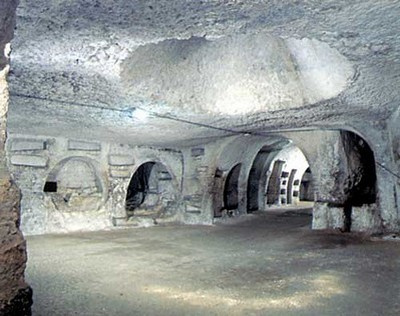
Catacomba di S.Giovanni Rotonda delle Sette Vergini 
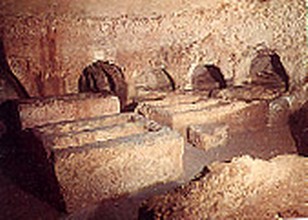
l
Antica pianta delle catacombe
A nord-ovest di Vigna Cassia, presso la chiesa in rovina di S. Giovanni Evangelista, si possono visitare le importanti catacombe di S. Giovanni. Si tratta di un,.complesso tardo, realizzato dopo la pace costantiniana, secondo un progetto omogeneo. Ciò spiega l'aspetto regolare e la monumentalità dell'insieme, che si organizza intorno a un asse principale orientato da nord-est a sud-ovest, ricavato anch'esso da un acquedotto di età classica. Su di esso confluiscono numerose gallerie perpendicolari, tutte caratterizzate dai grandi arcosoli polisomi. Periodicamente lo spazio si dilata in ambienti più ampi, quadrangolari o circolari. Particolarménte caratteristiche le grandi rotonde coperte a cupola, con lucernaio centrale: prescindendo da una anonima, esse recano i nomi di Éusebio, delle Sette Vergini, di Antiochia e di Adelfìa. Quest'ultima (C) è così denominata dal grande sarcofago di IV secolo con scene dell'Antico e del Nuovo Testamento che ne proviene, ora conservato nel Museo di Siracusa. Al di sopra del medaglione con il ritratto dei due coniugi è incisa l'iscrizione con il nome di Adelfìa e del comes Balerius, nel quale si è voluto identificare un governatore di Sicilia intorno al 330, L. Aradio Valerio Proculo Populonio. Si conferma così il carattere eccezionale della catacomba, destinata evidentemente a ospitare i defunti della classe dirigente siracusana del IV secolo.
On the north-west of Vigna Cassia, close the destroyed church of S. Giovanni Evangelista, it’s possible to visit the important catacombs of S. Giovanni. It’s about a complex, realised after the Constantine peace, according to an homogeneous project. It explains the regular aspect and the monumentality of the whole structure, organised around a main axes oriented from north-east to south-west, also derived from an aqueduct of the classical period. Onto it merge several perpendicular galleries, all characterised by big arcosolia with different shapes. Periodically the space expands in more wide rooms, quadrangular or circular in shape. Particularly characteristic are the big rounds covered by a dome, with a central skylight: having nothing to do with an anonymous, they take the names of Eusebio, of the Seven Virgins, of Antiochia and of Adelfia. The latter (C) is so called by the big sarcophagi of the IV century with scenes of the Ancient and the New Testament, now conserved in the Museum of Siracusa. Above the medallion with the portrait of husband and wife is incised the inscription with the name Adelfia and the COMES Belarius, in which it has been identified a governor of Sicilia around 330, L. Aradio Valerio Proculo. It confirms the exceptional aspect of the catacomb, destined to host the deads of the Siracusan ruling upper class of the IV century.
Tomba del vescovo Siracosio
Catacomba di S. Giovanni, Galleria principale
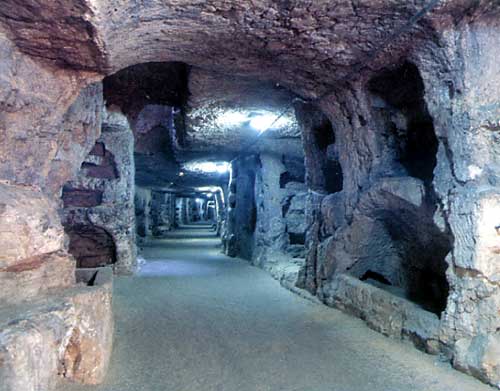
Catacomba di San Giovanni
Si deve a Paolo Orsi la serie di indagini sistematiche, condotte negli anni 1893-1909, che hanno dato la veste attuale alla catacomba in esame. La catacomba deve la sua celebrità alla scoperta fortuita del famoso sarcofago di Adelfia (attualmente esposto nella sala centrale del Museo Archeologico Regionale P. Orsi in attesa di confluire nella sezione romano-cristiana, in fase di allestimento), uno dei pochi sarcofagi a doppio registro restituiti dagli scavi, rinvenuto nel 1872 da Saverio Cavallari in una rotonda del settore meridionale sulla quale ci soffermeremo oltre. Non conosciamo la denominazione antica di questa catacomba e, a differenza dei cimiteri romani, non riusciamo a ricostruire le tracce dell'esistenza di uno o più martiri, cui poteva essere dedicata la catacomba; la dedica a S, Giovanni Evangelista è legata all'intitolazione al santo della basilica soprastante in età normanna.
Catacomba di S. Giovanni , Pianta Führer-Grieshimer
Non diversamente da ciò che avviene nelle catacombe romane, ma con una monumentalità maggiore, il progetto prevede la realizzazione di un vero e proprio piano urbanistico regolare per la città sotterranea dei morti, con uno sfruttamento intensivo di preesistenti strutture idrauliche. Per la creazione della strada principale si utilizzò il percorso di un acquedotto di età classica (ritroveremo le sue tracce lungo tutto il decumanus maximus).
A differenza dei cimiteri di Vigna Cassia e S. Lucia la catacomba di S. Giovanni nasce per servire una comunità che non doveva più nascondere la fede cristiana, nel clima successivo alla Pace della Chiesa, ed è lo stesso monumento a fornircene la prova con la grandiosità della sua architettura. I tipi di sepoltura sono canonici: loculi (cavità rettangolari con il lato lungo a vista, la cui chiusura si effettuava mediante tegole, lastre di marmo, mattoni); un tipo di sepoltura, più ricercata rispetto al loculo, è l'arcosolio, un arca scavata nel vivo della roccia, chiusa orizzontalmente da una tabula detta mensa; sopra la sormontava una nicchia quadrilunga o, come nel caso nostro, arcuata. L'arcosolio conteneva di solito due corpi, ma poteva avere una capacità doppia e nella forma particolare, che costituisce una prerogativa di Siracusa, anche una ventina di posti. Presente nei cimiteri sotterranei è anche la forma, il sepolcro scavato nel pavimento, proprio delle necropoli all'aperto.
Una sepoltura privilegiata è sicuramente quella collocata all'inizio della seconda galleria settentrionale, come ci suggerisce la lastra di copertura del sepolcro con i trefori, indizio di un rito antico, che precede l'avvento del cristianesimo e che si protrae nel tempo fino ad arrivare ai nostri giorni: il rito del refrigerìum, letteralmente il rinfresco. Nell'anniversario della morte, dies natalis dell'anima alla vita eterna, i vivi si consolano versando vino, latte, miele e altro al loro caro attraverso i fori ricavati nella lastra di copertura.
Continuiamo a percorrere la stessa galleria e svoltiamo a destra per immetterci nella camera trapezoidale (cubiculum A) Distinguiamo sulle pareti tracce di una pittura povera che, priva di scene figurate, si affida a semplici bande o a reticoli (questi ultimi allusivi del giardino paradisiaco) per personalizzare alcuni arcosoli.
Da questa camera ci immettiamo a sinistra in un vero e proprio pantheon sotterraneo per accedere al quale ci serviremo di una monumentale scala d'accesso, sulle cui pareti si distinguono le tracce inequivocabili della presenza in antico di una serie di colonne sormontate da capitelli. All'interno della rotonda, cui è stato imposto il nome di Antiochia , per il sarcofago costruito che emerge dall'anello di tombe scavate nella roccia, merita di essere menzionato un arcosolio caratterizzato da una disposizione a terrazzamento con efficace effetto ascensionale. Anche nel caso in esame sfuggono i possibili committenti di questo spazio privatizzato del cimitero.
Ritorniamo nel cimitero della comunità. E' infatti evidente che all'origine il nostro si configura come un cimitero comunitario progettato in funzione di un tipo pressoché esclusivo di sepolture, arcosolio a deposizione multipla, per poi snaturarsi al fine di creare spazi privati per l'aristocrazia locale o di passaggio e per i rappresentanti della Chiesa (creazione delle rotonde).
Alla fine della terza galleria Nord, girando a sinistra, rientriamo nel decumanus maximus per soffermarci davanti alla decorazione pittorica di un arcosolio isolato e riservato ad un'unica, importante sepoltura, presumibilmente appartenuta ad una vergine siracusana; una sovrapposizione di pitture ed epigrafi dipinte e graffite non facilita l'individuazione del proprietario originario di questo sepolcro. In questa sede ci si limita a leggere solo le immagini della parete superiore dell'arcosolio (prima metà del V sec.): è riprodotta una scena canonica in cui la defunta, posta al centro, è accolta dagli apostoli Pietro (con le chiavi) e Paolo sullo sfondo del giardino paradisiaco (decorazione floreale sparsa) per iniziare la vita ultraterrena. Su tutto domina il Cristo, presente nel cristogramma (formato dalle prime due iniziali del nome di Cristo in greco sovrapposte), affiancato in questo caso dalle due lettere apocalittiche (alpha e omega, rispettivamente prima e ultima lettera dell'alfabeto greco) che stanno a indicare che Cristo è il principio e la fine di tutte le cose. Proseguendo individuiamo sulla destra, sulla lunetta di un arcosolio, una Madonna con bambino mentre ritroviamo una delle figure più diffuse nella pittura catacombale, l'orante, su un'altra lunetta collocata all'interno del cosiddetto arcosolio pompeiano.
Torniamo indietro e imbocchiamo la prima galleria percorribile a sinistra che ci condurrà nella regione meridionale del cimitero. La prima rotonda prende il nome di Marina da un iscrizione graffita e datata nel primo venticinquennio del V sec. sulla base di una recente edizione. Nella breve galleria meridionale, senza sbocco, che si diparte dalla rotonda di Marina si distingue il presunto arcosolio del vescovo Siracosio, citato in un epigrafe rinvenuta in una fossa terragna limitrofa nella quale si dice che i defunti acquistarono volutamente il sepolcro vicino a quello del vescovo Siracosio. E' quindi soltanto un ipotesi quella che vede nell'arcosolio con lastra incisa, ancora in situ, la sepoltura nobile di un rappresentante della gerarchla ecclesiastica; si distinguono chiaramente il cristogramma dotato delle due lettere apocalittiche alpha e omega e due barche a forma di pesci.
Catacomba di S. Giovanni, Rotonda di Adelfia
Dalla rotonda di Marina una galleria conduce alla seconda rotonda, detta di Adelfia, e al nicchione che accolse la sepoltura di una donna di rango senatoriale in uno dei pochi sarcofagi a doppio registro conosciuti in tutto il mondo cristiano. Il sarcofago si presenta nella cassa come un vero e proprio riassunto delle più importanti scene tratte dal vecchio e dal nuovo testamento, mentre al centro e all'interno di una conchiglia sono presentati i ritratti di due coniugi defunti. Il testo dell'iscrizione, collocata sul coperchio del sarcofago, fa riferimento soltanto alla donna e non ad entrambi i coniugi: Qui giace Adelfia clarissima femina, moglie del conte Valerìus. Chi sono dunque Valerius e Adelfia? Attorno ai loro nomi, ma soprattutto alla loro identificazione, ruotano gli enigmi non ancora risolti della catacomba di S. Giovanni, che riguardano la cronologia dell'intervento monumentale sul nicchione (tempietto) e la datazione del sarcofago .
Dalla rotonda di Adelfia raggiungiamo la rotonda dei sarcofagi , caratterizzata dalla presenza di casse di sarcofagi scavati nella roccia e altri costruiti, simili ad altri già notati in diversi settori della catacomba. Ciò che sorprende è naturalmente la concentrazione di queste sepolture monumentali al punto da far pensare che esse potessero appartenere ad una comunità religiosa. Gli indizi sono molto pochi, per la verità, e fra questi merita di essere segnalata l'epigrafe delle beate vergini Fotina e Filomena, vissute l'una fino a 80 anni, l'altra fino a 84 anni.
L'ultima tappa del nostro viaggio sotterraneo è il cubicolo di Eusebio, che ha una struttura diversa dagli altri spazi privati della regione meridionale della catacomba, ma sembra ricavato comunque dall'allargamento di una cisterna preesistente. Il nome Eusebio deriva, ancora una volta, da un'iscrizione rinvenuta sulla sepoltura monumentale a tre livelli visibile alla sinistra del cubicolo, che merita di essere ricordato anche per un'altra testimonianza, con un valore particolare per i siracusani: il rinvenimento di un'epigrafe (di Euskia) attestante il culto di S. Lucia nel V sec.
Catacombs of Saint Giovanni
In the Paolo Orsi Museum the series of systematic survey, lead during the 1893-1909, which gave the actual aspect to the catacomb studied. The catacomb is famous thanks to the chance discovery of the known sarcophagi of Adelfia (actually exposed in the central room of the Regional Archaeological Museum P. Orsi waiting to be included in the Roman-Christian section, still in the phase of preparation), one of the few sarcophagi with a double register given by the excavations, found in 1872 by Saverio Cavallari in a round of the southern sector, of which we will discuss later. We don’t know the ancient name of this catacomb; the dedication to S. Giovanni Evangelista is linked to the title to the Saint of the basilica SOPRASTANTE of the Norman period.
It’s not different for what happens in the roman catacombs, but with a bigger monumentality, the project consist in the realisation of a mere urban regular plan for the underground city of the dead, with an intensive exploitation of the pre-existing hydraulic structures. For the creation of a main road, it was used the path of an aqueduct of the classical period (we’ll find its traces along all the decumanus maximus).
Differing from the cemeteries of Vigna Cassia and Saint Lucia, the catacomb of S. Giovanni was meant to be used by a community, who didn’t hide the Christian credo Anymore, after the Peace of the Church, and it’s the same monument giving us the proof with the greatness of its architecture. The types of burying are typical canonical: loculi (rectangular cavities with the long side visible, the shutting was done through tiles, marble slab, bricks); a type of burying , more particular compared with the loculum, is the arcosolium, a chest excavated in the rock, horizontally closed by a tabula called mensa; above it there was a niche long and squared or, as in this case, arched. The arcosolium usually contained two bodies, but it could have a double capacity and particular in the shape, which is a peculiarity of Siracusa, even twenty places. Present in the underground cemeteries is also the shape, the sepulchre excavated in the floor, in the outdoor necropolis.
A privileged burying is surely that one collocated at the beginning of the second northern gallery, as suggests us the covering slab of the sepulchre with the trefori, sign of an ancient rite, preceding the arrival of the Christianity and it continuates through times up to nowadays: the rite of refrigerìum, literally the refreshment. For the anniversary of the death, dies natalis of the soul to the neverending life, the alive console each other pouring wine, milk, honey and other things to their beloved through the holes derived in the slab used for the covering.
Keep passing through the same gallery and turning on the right, to go in the trapezoidal room (cubiculum A).on the walls are distinguished traces of a poor painting which, lacking of performing scenes, entrust to simple lines or nets (the latter alludes to the eden) to personalise some arcosolia.
Through this room on the left there’s the entrance to a mere underground pantheon, decorated by a monumental access staircase, where in the walls is possible to perceive the unequivocal traces of the presence of an antique series of columns surmounted by capitals. Inside the round, called Antiochia, for the sarcophagus built, emerging from the ring of tombs excavated in the rock, deserves to be mentioned an arcosolium characterised by a disposition terrace-shaped with an impressive ascension effect. Also in this case we don’t know the possible purchasers of this private space of the cemetery.
Back to the cemetery of the community, it’s clear that at the origin it was a common cemetery, projected for a specific type of burials, arcosolium for multiple deposition, converting to create private places for the local aristocracy, momentary burying and for the representatives of the Church (the creation of the rounds).
At the end of the third North gallery, turning left, is the access back to the decumanus maximus to stand still in front of the painted decoration of an isolated arcosolium and reserved to a unique, important burial, maybe belonging to a Siracusan virgin; a superposition of paintings and epigraphs painted and graffiti, makes really hard the work for understanding the original owner of this sepulchre. In this case we only read the images on the superior wall of the arcosolium (first part of the V century): that’s reproduced a canonical scene, where the dead, placed in the centre, is received by the Apostles Pietro (with the keys) and Paolo in the background of the paradisiacal garden (spread flower decoration), to start her new life beyond. Christ dominates on everything, present in the chistogram (formed by the first two initials superposed of the name OF Christ written in the Greek alphabet), with the two apocalyptic letters (alpha and omega, the first and the last letter of the Greek alphabet), indicating that Christ is the beginning and the end of everything. Moving on, on the right, on the lunette of the arcosolium, we individuate a Virgin Mother and child while there is one of the most typical figures of the catacomb painting, the praying man, in another lunette collocated inside of the so-called Pompeian arcosolium.
Back to the first gallery on the left, we arrive to the southern region of the cemetery. The first round is called Marina, by an inscription graffiti and dated in the first twenty-five years of the V century, on the basis of a recent edition. In the short southern gallery, which is closed, starting from the round Marina, it’s the presumed arcosolium of the bishop Siracosio, quoted in an epigraph found in a close deep, in which it is written that the dead decided to buy the sepulchre close to that of the bishop Siracosio. So, it’s only an hypothesis that one which sustain that the arcosolium with incised slap, still in situ, the noble burial of a representativeof the ecclesiastic hierarchy; it’s clearly distinguished the christogram with the two apocalyptic letters alpha and omega and two fish-shaped ships.
From the round Marina a gallery condices to the second round, called Adelfia’s, to the big niche where is conserved the burial of a noble woman, wife of a senator in one of the few sarcophagi with double register known in all the Christian world. The sarcophagus illustrates a summary of the most important scenes from the old and the new testament, while in the centre and inside of a shell there are the portraits of two dead spouses. The text of the inscription, collocated on the cover of the sarcophagus, refers only to the woman and not to both spouses: Here rests Adelfia gentle woman, wife of the count Valerìus. So, who are Valerìus and Adelfia? About their names, but most about their identification, we have lots of mysteries still not solved, but also other mysteries like the chronology of the monumental intervention on the big niche (little temple) and the dating of the sarcophagus.
From the Adelfia’s round we arrive to the round of sarcophagi; characterised by the presence of coffin of sarcophagi excavated in the rock and others built, similar to the others just seen in different sectors of the catacomb. What is astonishing is obviously the concentration of this monumental burials, so that we are driven to think to think that they could belong to a religious community. The clues are really few, in reality, and among these deserves to be mentioned the epigraph of the blessed virgins Fotina e Filomena, they lived the previous up to the age of eighty, the latter up to eighty-four. The last stage of our underground trip is the cubicle of Eusebio, which has a different structure from the other private spaces of the southern region of the catacomb, but it seems obtained by the enlargement of a pre-existing cistern. The name Eusebio derives, once more, from an inscription found in a three-level monumental burial, visible on the left of the cubicle, which deserves to be reminded also for another proof, with a particular value for the Siracusans: the finding of an epigraph (by Euskia) witnessing the cult of S.Lucia in the V century.

